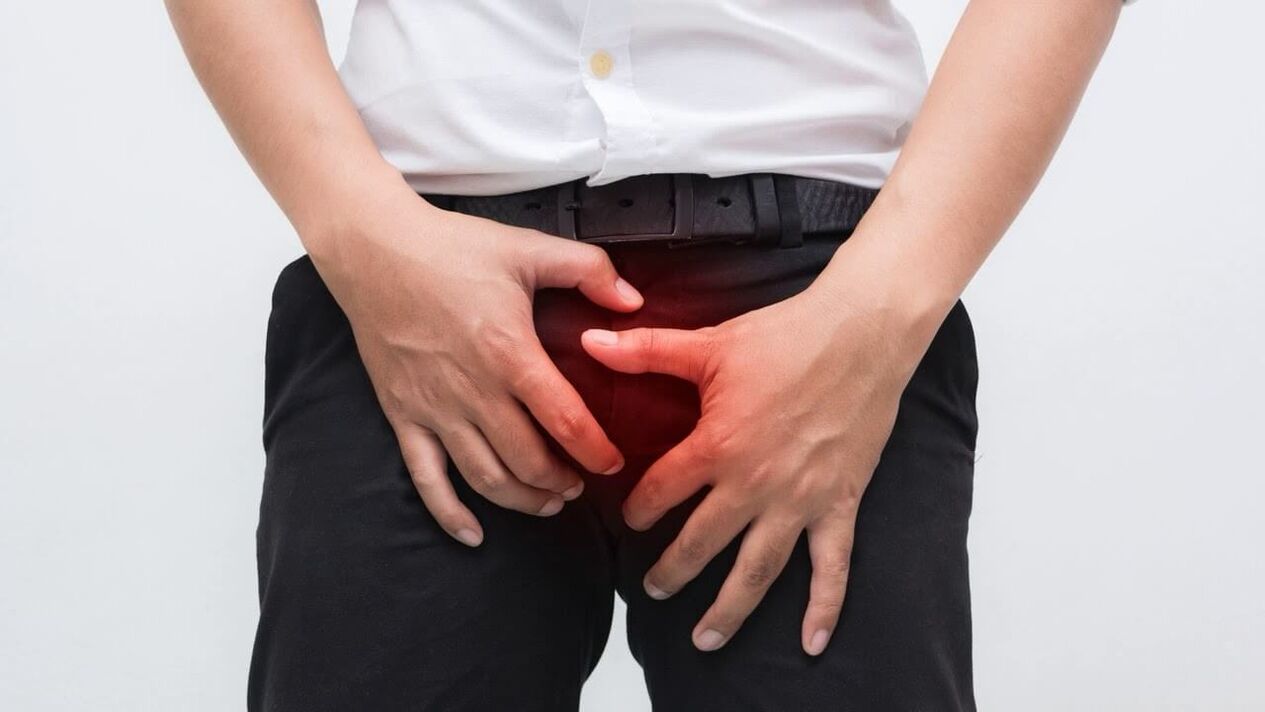Frequent painful urination, perineal discomfort, pyrexia, decreased potency and libido are problems faced by 80% of men aged 45-50, but most of them delay seeing a doctor until the pain becomes unbearable. Unpleasant symptoms indicate inflammation of the prostate, which requires urgent treatment: prostatitis in men quickly becomes chronic and can lead to infertility, sexual dysfunction and oncology.
What is prostatitis
The prostate gland is an organ that resembles a chestnut in size and shape and is located below the bladder. Its bottom is surrounded by a crotch. The prostate in men performs the following functions: secretory - the production of sex hormones and secretions that determine the quality of sperm, and a barrier - the separation of the processes of ejaculation and urination.
The second name of the gland is popularly used to denote a common disease that affects about half of the male population: the older the man, the higher the risk of the disease - prostatitis is rarely diagnosed in boys aged 20-25. The disease is dangerous with serious complications, so it is important to recognize it at an early stage.
The therapeutic course takes up to 14 days, for several more months the patient must strictly adhere to preventive measures. If the disease has managed to take a chronic form, the risk of recurrence is 50%.
Classification
Treatment of the prostate gland in men is sometimes delayed for years. The disease temporarily passes asymptomatically, to remind itself after a few months with a sharp decrease in immunity, violation of the intestinal microflora and other stressful situations for the body. Male prostate disease has several forms:
- Sharp. It is characterized by a bacterial infection of the tissues of the prostate gland. Typical signs are severe pain syndrome, critical fever. It is necessary to treat the disease in a hospital setting;
- Chronic bacterial. Periodic remission of symptoms is often perceived as a signal of recovery, but this is an illusion - each subsequent exacerbation is more severe than the previous ones due to the development of purulent foci, the appearance of tumors;
- Asymptomatic. The lack of symptoms in the active development of the disease. Such a prostate in men is often found by chance, according to the results of urine analysis;
- Granulated. Cessation of gland function due to connective tissue overgrowth;
- Pelvic pain syndrome. Difficult to diagnose form, accompanied by constant pain in the pelvic area, neurological and psychoemotional disorders.
What does the prostate mean in men? First of all, the diagnosis means the need to reconsider your lifestyle, patience and follow the doctor's recommendations - treatment can take a long time.

What causes the prostate in men?
The reasons
The exact algorithm for the onset of the inflammatory process in the prostate gland has not been established, but a pattern has been revealed: the likelihood of disease increases with a decrease in overall immunity. Why is this happening? Infectious pathogens, falling on the mucous membranes of a healthy person, are in a "sleeping" state and do not spread until the protective functions of the body are weakened. Thus the male prostate begins to develop.
Factors that increase the risk:
- Hypothermia;
- Injuries and bruises of the perineum;
- PPB;
- Inactive lifestyle, sedentary work;
- Inadequate sex life;
- Contraception by interruption of sexual intercourse (incomplete ejaculation occurs);
- Stress, neurosis, depression;
- Bad habits - alcohol abuse, smoking;
- Drug intoxication.
Doctors also point to a link between the fashion for tight pants that press on the genitals and the increase in morbidity. Prostate symptoms in men who prefer tight-fitting jeans are much more common than among free-form adherents.
Chronic etiology
Persistent prostatitis in men is a consequence of improper treatment (or its complete absence) of acute inflammation of the prostate. Causes of exacerbation: sexually transmitted diseases, stressful situations at work and in the family, forced restriction of emptying the rectum or bladder, wearing tight underwear made of synthetic fabrics.
An additional factor is congestion in the pelvis due to low mobility. A patient who has experienced what a prostate is in men in the acute form should take all measures to prevent recurrence: first walk more to activate blood circulation.
Inflamed prostate gland in men symptoms
Acute prostatitis
There are three types of this form of the disease: catarrhal, follicular, parenchymal (the most dangerous). In the first case, the discomfort begins with pulling pains in the pubic area and a slight rise in temperature. Soon a man notices discomfort during urination or intercourse, a constant feeling of fatigue.
The follicular type is characterized by severe pain in the penis and lower back: it does not allow the intestines and bladder to empty completely. If left untreated, the third type of disease develops.
Parenchymal prostate in men what is it? Difficulty urinating becomes complete retention of urine, body temperature reaches 39-40 degrees, mucosal discharge from the rectum appears. The condition is serious and requires immediate hospitalization.
Chronic prostatitis
The symptoms of this form are often blurred, unexpressed, which complicates the diagnosis. The pain syndrome becomes permanent, is localized in the lower abdomen and is quite easily tolerated. Discomfort increases after intimacy.
Urination is slightly difficult - the urine stream is intermittent. Desires become more frequent. After physical exertion, an uncharacteristic discharge occurs on the head of the penis. Erectile dysfunction is possible. The temperature is maintained around 37 - 37, 3 C.
If symptoms of chronic prostatitis are observed in men, treatment should not be delayed: slow inflammation can lead to infertility.

Diagnosis
A timely visit to a urologist is the best solution in case of suspected inflammation of the prostate gland. During the meeting, the doctor will ask a few questions about the patient's health and review the patient's medical record to gather a medical history. In addition, an external examination and palpation of the organ through the rectum is performed.
A number of tests have been ordered to clarify the diagnosis:
- Secret analysis;
- Prostate ultrasound;
- PCR material sampling;
- MRI of the pelvic organs.
If necessary, the flow rate of urine during urination is measured with a special device, a uroflowmeter. The measurements are performed in the clinic: the patient empties the bladder in a special container with a sensor that shows a graphic image at the end of the process.
Prostate gland in men treatment
Before prescribing a course of treatment, it is important to identify all the factors that provoked the inflammatory process. When the exact cause of prostatitis in men is established, treatment is more productive. The urologist develops an individual comprehensive program that includes the following elements:
- Drug therapy. In case of viral etiology, antiviral drugs are prescribed, and in case of an infectious lesion - antibacterial drugs. In parallel, anti-inflammatory suppositories and creams, immunostimulating agents and, if necessary, analgesics are used;
- Physiotherapy. The method is determined based on the picture of the disease. This can be electrophoresis, magnetic therapy, laser sessions, UHF;
- Massage. The procedure is performed by the doctor or (after training) by the patient's spouse - emotional comfort and family support are of great importance for the sick person. Massage improves the outflow of purulent-inflammatory secretions from the ducts of the prostate gland.
The effectiveness of the prescribed therapy is assessed after 10-14 days: if there is a positive trend, the course continues after a short break. In the absence of improvements, a decision is made to cancel some drugs and procedures, replacing them with others.

Prevention
Prostate in men, symptoms and treatment is a topic that every member of the stronger sex who has reached reproductive age should study in detail. Awareness of preventative measures will help avoid inflammation.
How to prevent prostatitis? It is recommended to avoid hypothermia and unprotected sex, to be regularly tested for sexually transmitted diseases. It is necessary in time to empty the bladder, to choose pants with wide legs.






















